Proper way to use server component inside a client component in Next.js
Last Updated :
16 Apr, 2024
Next.js, a popular React framework, helps to build powerful web applications with ease. One of its standout features is the ability to seamlessly integrate server-side logic alongside client-side components. This allows for dynamic content rendering, efficient data fetching, and enhanced user experiences. In this article, we’ll explore how to use server-side components within client-side components in Next.js applications.
Prerequisites
What are Server Components ?
Server components were first introduced in Next.js 13 and are rendered on the server which reduces the amount of JavaScript shipped to the client computer, enhancing the performance of the website. All the components are by default server components and you have to specify ‘use client’ at the of the file to convert it to client rendered component. Server components are better for Search Engine Optimization and there is no initial white screen like normal react components. However, importing a server component inside a client component will be of no use because it will rendered on the client side.
Steps to Initialize a Next.js project
Step 1: To initialize next.js project enter the below command in terminal.
npx create-next-app@latest
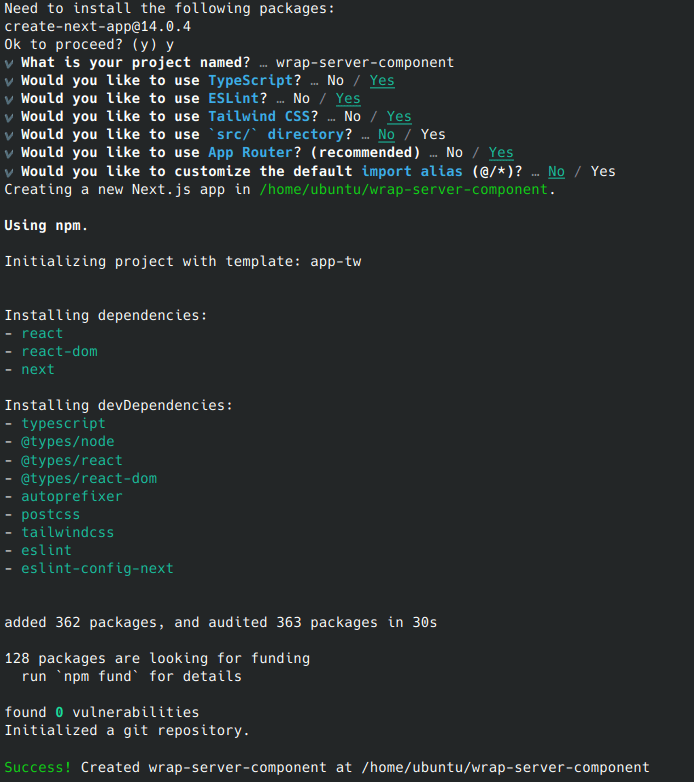
Project initialisation
Step 2: To start the app type in terminal
npm run dev
Step 3: Create components folder and create 2 files ClientComp.tsx and ServerComp.tsx inside the folder. If you are using Linux , then you can do the same by running the command below.
mkdir components && cd $_ && touch {ClientComp,ServerComp}.tsxDependencies:
"dependencies": {
"react": "^18",
"react-dom": "^18",
"next": "14.0.4"
},
"devDependencies": {
"typescript": "^5",
"@types/node": "^20",
"@types/react": "^18",
"@types/react-dom": "^18",
"autoprefixer": "^10.0.1",
"postcss": "^8",
"tailwindcss": "^3.3.0",
"eslint": "^8",
"eslint-config-next": "14.0.4"
}Folder Structure:
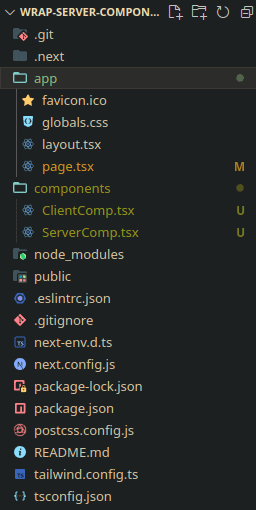
Project structure
Example: Now that we have initialised Next.js project, lets create simple client and server component.
JavaScript
//app/page.tsx
import ClientComp from '@/components/ClientComp'
import React from 'react'
const page = () => {
return (
<ClientComp />
)
}
export default page
//components/ClientComp.tsx
"use client";
import { useState } from "react";
import ServerComp from "./ServerComp";
const ClientComp: React.FC = () => {
const [state, setState] = useState(0);
return (
<div className="w-full h-screen flex
justify-center items-center">
<div className="w-2/3 h-2/3
bg-pink-300 flex flex-col
justify-center items-center">
<p className="text-3xl font-semibold">
Client Component</p>
<p className="mb-5">Rendered on Client side</p>
<div className="flex gap-3 border border-black
rounded-lg p-2 px-5 m-2">
<p className="text-2xl font-semibold">
Count: {state}</p>
<button
className="bg-blue-500 hover:bg-blue-700
text-white font-bold py-2 px-4 rounded"
onClick={() => setState(state + 1)}
>
Click
</button>
</div>
<ServerComp />
</div>
</div>
);
};
export default ClientComp;
//components/ServerComp.tsx
const ServerComp = () => {
console.log("This console log is from the server component.")
return (
<div className="w-2/3 h-2/3 bg-blue-300
flex flex-col justify-center items-center border border-black">
<h1 className="text-3xl font-bold">Server Component</h1>
<p className="text-xl">This component is rendered on the server.</p>
</div>
)
}
export default ServerComp
Output:
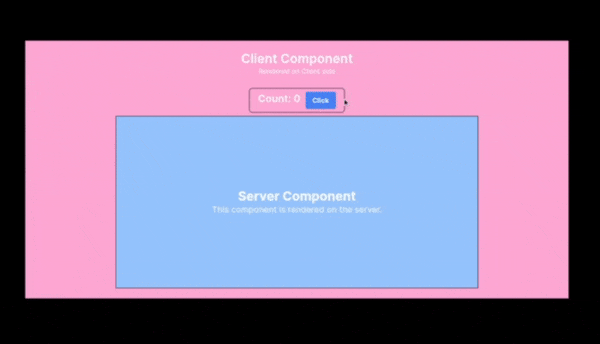
Server Component in Next JS
Looks good, then what is the issue?
Problem:
Server component is not rendered in server side but is being rendered on client side. You can verify this by going to source tab in chrome developer tools.
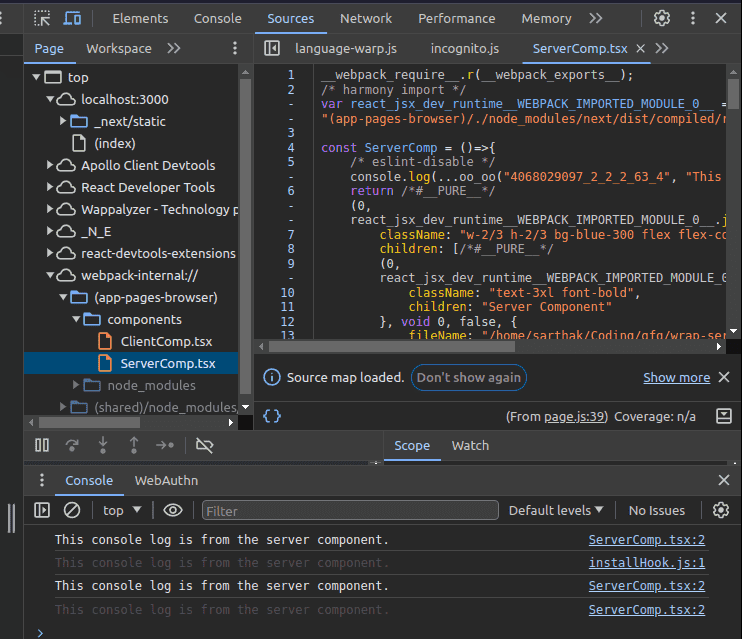
Server component is rendered in client side
In the source tab of debugging tools, we can see ServerComp.tsx file is visible. console.log() statement present in <ServerComp/> is printing in browser console which means the component is rendering in client side. So all the confidential information present in server component now can be seen seen by client and extra unnecessary JavaScript bundle is being shipped to client making the website slow, killing the purpose of using server components.
Solution:
The page component is server side. So if we can import the server component and pass it as a child prop to client component. In this way server and client components are decoupled and it will solve our issue. Place the children where you want to data to be placed. Behind the scene, Next.js is rendering the server component before the rendering of client component.
JavaScript
//components/ClientComp.tsx
"use client"
import { useState } from "react"
const ClientComp: React.FC
< { children: React.ReactNode } > = ({ children }) => {
const [state, setState] = useState(0)
return (
<div className="w-full h-screen flex
justify-center items-center">
<div className="w-2/3 h-2/3 bg-pink-300
flex flex-col justify-center items-center">
<p className="text-3xl font-semibold">Client Component</p>
<p className="mb-5">Rendered on Client side</p>
<div className="flex gap-3 border border-black
rounded-lg p-2 px-5 m-2">
<p className="text-2xl font-semibold">
Count: {state}</p>
<button className="bg-blue-500 hover:bg-blue-700
text-white font-bold py-2 px-4 rounded"
onClick={() => setState(state + 1)}
>
Click
</button>
</div>
{children}
</div>
</div>
)
}
export default ClientComp
//app/page.tsx
import ClientComp from '@/components/ClientComp'
import ServerComp from '@/components/ServerComp'
import React from 'react'
const page = () => {
return (
<ClientComp>
<ServerComp />
</ClientComp>
)
}
export default page
Now we are passing server component from page component which is a server component to client component. If you see now see source tab in developer tools, server component will not show and console logs are now appearing as the it is rendering on server side.
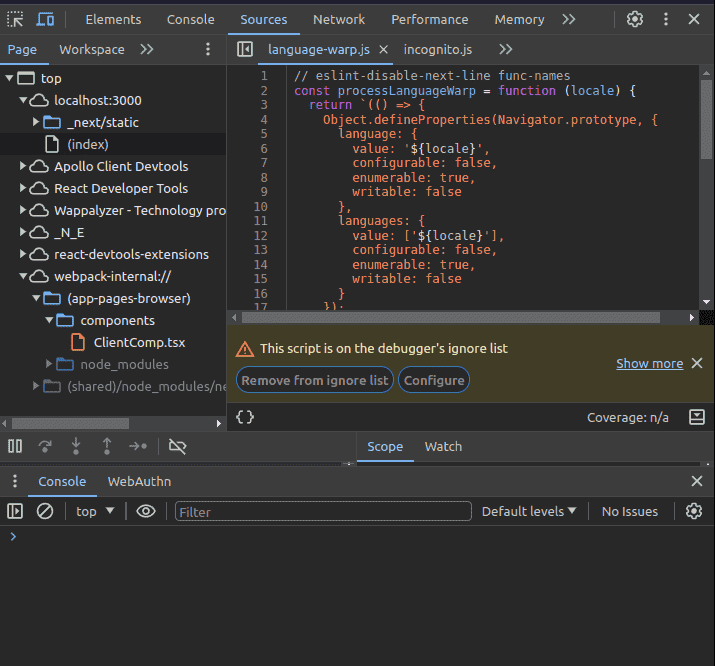
Server component is rendered in serve
Share your thoughts in the comments
Please Login to comment...